Human telomerase reverse transcriptase (hTERT) is a novel target of the Wnt/β-catenin pathway in human cancer
- PMID: 22854964
- PMCID: PMC3463325
- DOI: 10.1074/jbc.M112.368282
Human telomerase reverse transcriptase (hTERT) is a novel target of the Wnt/β-catenin pathway in human cancer
Abstract
Telomerase activation plays a critical role in human carcinogenesis through the maintenance of telomeres, but the activation mechanism during carcinogenesis remains unclear. The human telomerase reverse transcriptase (hTERT) promoter has been shown to promote hTERT gene expression selectively in tumor cells but not in normal cells. Deregulation of the Wnt/β-catenin signaling pathway is reported to be associated with human carcinogenesis. However, little is known about whether the Wnt/β-catenin pathway is involved in activating hTERT transcription and inducing telomerase activity (TA). In this study, we report that hTERT is a novel target of the Wnt/β-catenin pathway. Transient activation of the Wnt/β-catenin pathway either by transfection of a constitutively active form of β-catenin or by LiCl or Wnt-3a conditioned medium treatment induced hTERT mRNA expression and elevated TA in different cell lines. Furthermore, we found that silencing endogenous β-catenin expression by β-catenin gene-specific shRNA effectively decreased hTERT expression, suppressed TA, and accelerated telomere shortening. Of the four members of the lymphoid-enhancing factor (LEF)/T-cell factor (TCF) family, only TCF4 showed more effective stimulation on the hTERT promoter. Ectopic expression of a dominant negative form of TCF4 inhibited hTERT expression in cancer cells. Through promoter mapping, electrophoretic mobility shift assay, and chromatin immunoprecipitation assay, we found that hTERT is a direct target of β-catenin·TCF4-mediated transcription and that the TCF4 binding site at the hTERT promoter is critical for β-catenin·TCF4-dependent expression regulation. Given the pivotal role of telomerase in carcinogenesis, these results may offer insight into the regulation of telomerase in human cancer.
Figures
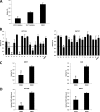

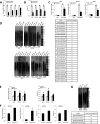
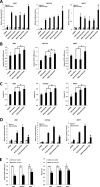

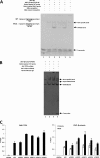
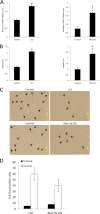
Similar articles
-
Phospholipase D1 drives a positive feedback loop to reinforce the Wnt/beta-catenin/TCF signaling axis.Cancer Res. 2010 May 15;70(10):4233-42. doi: 10.1158/0008-5472.CAN-09-3470. Epub 2010 May 4. Cancer Res. 2010. PMID: 20442281
-
N-glycosylation gene DPAGT1 is a target of the Wnt/beta-catenin signaling pathway.J Biol Chem. 2010 Oct 8;285(41):31164-73. doi: 10.1074/jbc.M110.149195. Epub 2010 Aug 6. J Biol Chem. 2010. PMID: 20693288 Free PMC article.
-
CREPT/RPRD1B, a recently identified novel protein highly expressed in tumors, enhances the β-catenin·TCF4 transcriptional activity in response to Wnt signaling.J Biol Chem. 2014 Aug 15;289(33):22589-22599. doi: 10.1074/jbc.M114.560979. Epub 2014 Jun 30. J Biol Chem. 2014. PMID: 24982424 Free PMC article.
-
[In situ analyses of molecular mechanisms of colorectal carcinogenesis].Pathologe. 2013 Nov;34 Suppl 2:269-73. doi: 10.1007/s00292-013-1821-y. Pathologe. 2013. PMID: 24196627 Review. German.
-
Mechanisms of human telomerase reverse transcriptase (hTERT) regulation: clinical impacts in cancer.J Biomed Sci. 2018 Mar 12;25(1):22. doi: 10.1186/s12929-018-0422-8. J Biomed Sci. 2018. PMID: 29526163 Free PMC article. Review.
Cited by
-
Hedgehog signaling regulates telomerase reverse transcriptase in human cancer cells.PLoS One. 2013 Sep 25;8(9):e75253. doi: 10.1371/journal.pone.0075253. eCollection 2013. PLoS One. 2013. PMID: 24086482 Free PMC article.
-
Mutual regulation between chicken telomerase reverse transcriptase and the Wnt/β-catenin signalling pathway inhibits apoptosis and promotes the replication of ALV-J in LMH cells.Vet Res. 2021 Aug 19;52(1):110. doi: 10.1186/s13567-021-00979-x. Vet Res. 2021. PMID: 34412690 Free PMC article.
-
The role of telomeres and telomerase reverse transcriptase isoforms in pluripotency induction and maintenance.RNA Biol. 2016 Aug 2;13(8):707-19. doi: 10.1080/15476286.2015.1134413. Epub 2016 Jan 19. RNA Biol. 2016. PMID: 26786236 Free PMC article. Review.
-
Synergistic Effect of Expressed miR-128 and Puma Protein on Targeted Induction of Tumor Cell Apoptosis.Iran J Biotechnol. 2016 Sep;14(3):185-191. doi: 10.15171/ijb.1429. Iran J Biotechnol. 2016. PMID: 28959335 Free PMC article.
-
Beyond Telomeres: Unveiling the Extratelomeric Functions of TERT in B-Cell Malignancies.Cancers (Basel). 2025 Mar 30;17(7):1165. doi: 10.3390/cancers17071165. Cancers (Basel). 2025. PMID: 40227701 Free PMC article. Review.
References
-
- Blackburn E. H. (1991) Telomeres. Trends Biochem. Sci. 16, 378–381 - PubMed
-
- Perrem K., Bryan T. M., Englezou A., Hackl T., Moy E. L., Reddel R. R. (1999) Repression of an alternative mechanism for lengthening of telomeres in somatic cell hybrids. Oncogene 18, 3383–3390 - PubMed
-
- Greider C. W., Blackburn E. H. (1989) A telomeric sequence in the RNA of Tetrahymena telomerase required for telomere repeat synthesis. Nature 337, 331–337 - PubMed
-
- Blasco M. A., Hahn W. C. (2003) Evolving views of telomerase and cancer. Trends Cell Biol. 13, 289–294 - PubMed
-
- Kim N. W., Piatyszek M. A., Prowse K. R., Harley C. B., West M. D., Ho P. L., Coviello G. M., Wright W. E., Weinrich S. L., Shay J. W. (1994) Specific association of human telomerase activity with immortal cells and cancer. Science 266, 2011–2015 - PubMed
Publication types
MeSH terms
Substances
LinkOut - more resources
Full Text Sources
Other Literature Sources

